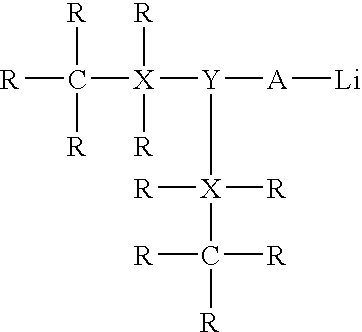Method of making alkoxy functionalized rubbery polymers
- Summary
- Abstract
- Description
- Claims
- Application Information
AI Technical Summary
Benefits of technology
Problems solved by technology
Method used
Image
Examples
example 1
[0059]In this experiment, 2000 g of a hexane premix containing about 20% monomer(s) consisting of 20% styrene and 80% butadiene was charged to a one gallon stainless steel reactor with an air-driven motor, a nitrogen inlet for providing an inert nitrogen atmosphere, and internal heating / cooling coils for temperature regulation. 0.5 mmol butyllithium, 3 mmol lithium t-butoxide, and 1 mmol N,N,N′,N′-tetramethylethylenediamine (TMEDA) were added to the premix. Polymerization was carried out at 65° C. and the reaction monitored using gas chromatography (“GC”) to detect for the presence of unreacted monomers.
[0060]After polymerization was completed, 3 mmol hexachlorodisiloxane, i.e., (Cl3Si)2O, was added to the reactor. Ethanol was added to shortstop the polymerization. The polymer cement was then removed from the reactor and stabilized with antioxidant. After evaporating hexanes, the resulting polymer was dried in a vacuum oven providing alkoxy functionalized styrene-butadiene rubber (S...
example 2
[0062]The procedure described in Example 1 was utilized in this example except that hexachloroditin oxide was used instead of hexachlorodisiloxane. GPC analysis suggested that the molecular weight of the alkoxy functionalized styrene-butadiene rubber was about 320,000 or about 4× that of its precursor, which suggested that the alkoxy groups from 2 mmoles lithium tertiary butoxide have been attached to the ditin oxide, i.e. the alkoxy groups have replaced chlorine atoms.
example 3
[0063]The procedure described in Example 1 was utilized in this example except that hexachlorodisilane was used instead of hexachlorodisiloxane. GPC analysis suggested that the molecular weight of the alkoxy functionalized styrene-butadiene rubber was about 240,000 or about 3× (i.e., Mw 240,000) that of its precursor, which suggested that the alkoxy groups from the 3 mmoles lithium tertiary butoxide have been attached to the disilane i.e. the alkoxy groups have replaced chlorine atoms.
PUM
 Login to View More
Login to View More Abstract
Description
Claims
Application Information
 Login to View More
Login to View More - R&D
- Intellectual Property
- Life Sciences
- Materials
- Tech Scout
- Unparalleled Data Quality
- Higher Quality Content
- 60% Fewer Hallucinations
Browse by: Latest US Patents, China's latest patents, Technical Efficacy Thesaurus, Application Domain, Technology Topic, Popular Technical Reports.
© 2025 PatSnap. All rights reserved.Legal|Privacy policy|Modern Slavery Act Transparency Statement|Sitemap|About US| Contact US: help@patsnap.com



